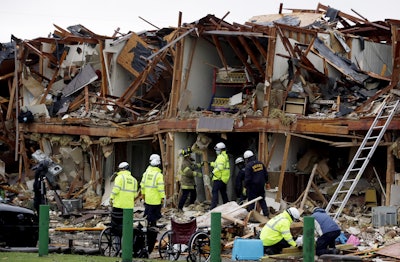
A fire that caused an explosion at a Texas fertilizer plant that killed 15 people in 2013 was a criminal act, federal authorities announced Wednesday.
Federal and state investigators said no arrests have been made but that they were investigating who was responsible for causing the fire at the West Fertilizer Co. facility on April 17, 2013, in the town of West. The fire caused ammonium nitrate to ignite, triggering a massive explosion that killed 15 people, injured hundreds and left part of the small town in ruins. It marked one of Texas' worst industrial accidents.
Alcohol, Tobacco, Firearms and Explosives special agent Robert Elder said investigators came to the conclusion after ruling out other reasonable causes, but he didn't release specifics. Inspectors have previously said three possible scenarios caused the fire: faulty electrical wiring, a short circuit in a golf cart stored at the plant, or arson.
"We have eliminated all reasonable accidental and natural causes," Elder said. "This was a criminal act."
Federal regulators had previously issued a report that found inadequate emergency response coordination and training and careless storage of potentially explosive materials contributed to the blast, which left a crater 90 feet wide and 10 feet deep. The U.S. Chemical Safety Board adopted recommendations earlier this year that federal regulators set higher standards for safe handling and storage of fertilizer-grade ammonium nitrate.
 (AP Photo)
(AP Photo)Federal regulators say the way the fertilizer was stored, with combustible materials nearby, and the lack of ventilation were contributing factors to the detonation. But they also cited a failure to conduct safety inspections of the plant, shortcomings in emergency response such as with hazmat training, and poor land planning that allowed development to sprout around the plant over the years.
Among those killed in the explosion were 12 emergency personnel, primarily ones with the West Volunteer Fire Department who responded to the initial blaze.
The Chemical Safety Board report approved by the board in January said the response to the fire was flawed for various reasons, including for not establishing an incident command center and a lack of understanding about the possibility of a detonation.
The report also noted that Texas had 80 plants that stored more than 5 tons of ammonium nitrate, a chemical used in fertilizer, and that 19 plants storing fertilizer-grade ammonium nitrate operated within a half-mile of a school, hospital or nursing home.
The West plant "was about 550 feet from the closest school, which sustained catastrophic damage as a result of the explosion, which could have resulted in additional loss of life had the school been in session at the time," the report noted. That explosion caused about $100 million in property damage, according to the Texas Department of Insurance, and insurance-related losses were approximately $230 million.






















